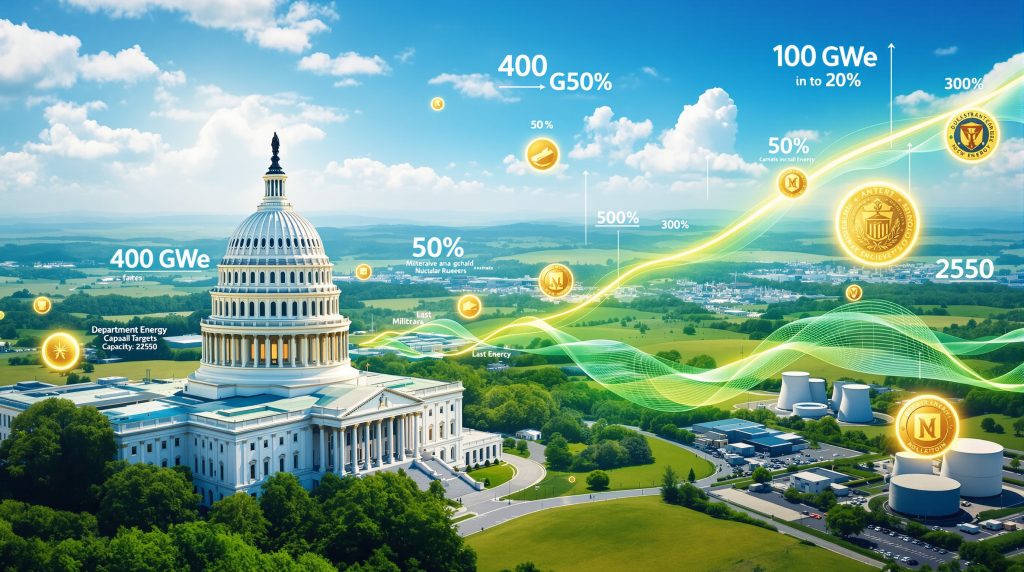How Deep Does Federal Nuclear Energy Oversight Actually Go?
The scope of US government involvement in nuclear energy extends far beyond what most Americans realise. Multiple federal agencies coordinate in an intricate framework that touches every aspect of the nuclear fuel cycle, from uranium extraction to reactor operations.
Multi-Agency Coordination Framework
The Nuclear Regulatory Commission operates as an independent regulatory authority, maintaining its role since 1974 to oversee safety standards and licensing procedures. However, the traditional 41-month design certification timeline is under intense pressure for reform as the Trump administration pushes for accelerated nuclear deployment.
The Department of Energy leads research and development initiatives while simultaneously exploring alternative pathways that could bypass conventional NRC approval processes. This dual approach creates parallel regulatory tracks designed to maintain safety oversight while dramatically reducing development timelines.
Meanwhile, the Department of Defense manages strategic nuclear applications, including plans for military installation reactors. The Interior Department controls vast federal land holdings across the western United States, positioning it as a crucial gatekeeper for uranium resource development.
Industry veterans note that government involvement is creating innovation levels not previously seen in the nuclear sector. This represents a fundamental shift from utility-led projects toward government-facilitated partnerships that leverage international capital rather than relying solely on taxpayer funding.
Executive Branch Policy Direction
Presidential executive orders are shaping nuclear strategy through cabinet-level coordination mechanisms. Trump's recent Trump's minerals order has established energy councils that prioritise nuclear development as a national security imperative, moving beyond traditional market-driven approaches.
Recent policy directions emphasise onshoring critical nuclear capabilities, including reactors, fabrication facilities, uranium conversion, and enrichment technologies. Executive branch involvement extends across all aspects of nuclear development, creating systemic rather than isolated regulatory changes.
A Bureau of Interior representative recently indicated that proposed uranium mining projects would be processed "much quicker than in the past" under current policies, provided they present defendable business plans and meet legal requirements. This signals streamlined federal land access procedures that could unlock significant domestic uranium resources.
What Are the Trump Administration's Nuclear Energy Expansion Goals?
The administration's nuclear ambitions represent the most aggressive expansion targets in decades, driven by emerging demand from data centres and strategic energy independence objectives.
Ambitious Capacity Targets Through 2050
| Year | Current Capacity (GWe) | Target Capacity (GWe) | Percentage Increase |
|---|---|---|---|
| 2025 | 100 | 100 | Baseline |
| 2030 | 100 | 150 | 50% increase |
| 2050 | 100 | 400 | 300% increase |
These expansion goals coincide with fundamental shifts in uranium demand forecasting. US utilities currently face approximately 11 million pounds per year of unfilled uranium requirements through 2029, jumping to 20 million pounds annually starting in 2030, according to Department of Energy analysis.
The World Nuclear Association's latest market study revealed what industry experts describe as an "overwhelmingly monumental" uranium supply gap. Their reference case projects production requirements of 390 million pounds by 2040, escalating to 530 million pounds in upper-case scenarios, far exceeding current production forecasts.
Reactor Construction Acceleration Plans
The centrepiece of expansion strategy involves a Cameco-Westinghouse agreement valued at $80 billion to construct 10 new reactors. However, financing mechanisms represent a departure from traditional approaches, with funding expected from Middle Eastern countries, Japan, and South Korea rather than direct US taxpayer investment.
Data centre power demands are creating new incentive structures that utilities cite as motivation for reconsidering reactor procurement. This marks a significant shift from post-Fukushima market conditions characterised by abundant fuel supplies and utility reluctance toward new construction.
Power uprates to existing facilities could contribute an additional 5 gigawatts of capacity through optimisation of current reactor performance. These modifications require less capital investment while providing meaningful capacity additions during the transition to new construction.
How Is the Government Reforming Nuclear Regulatory Processes?
Regulatory reform initiatives extend beyond incremental improvements, creating entirely new approval pathways designed to accelerate deployment while maintaining safety standards. Furthermore, these changes reflect how US government involvement in nuclear energy is evolving beyond traditional oversight models.
Nuclear Regulatory Commission Modernisation
Traditional NRC processes face pressure to accommodate industry demands for faster approvals. The commission's independent authority, established in 1974, must balance safety oversight responsibilities with administration goals for nuclear expansion acceleration.
Industry participants describe current conditions as "nuclear future shock", referring to accelerated change compressed into shorter timeframes that challenge traditional regulatory approaches. This includes simultaneous pressures from reactor restarts, small modular reactor development, and data centre demand growth.
Recent utility behaviour demonstrates market evolution, with several companies entering spot markets for small uranium volumes as testing mechanisms. When prices proved unfavourable, they withdrew temporarily, only to return later accepting higher prices with fewer available sources.
Department of Energy Alternative Pathways
DOE site-based reactor testing authorisation creates opportunities to demonstrate technologies outside conventional NRC approval processes. This parallel pathway approach facilitates proof-of-concept projects while maintaining regulatory oversight through alternative mechanisms.
New enrichment suppliers are emerging through government support programmes. General Atomics recently presented potential enrichment capabilities at industry conferences, indicating expanded domestic enrichment capacity beyond traditional suppliers.
Moreover, uranium market volatility has prompted government agencies to explore more stable supply chain arrangements through these alternative regulatory pathways.
Key Insight: The government is creating parallel approval pathways to accelerate nuclear development while maintaining safety standards.
Which Companies Are Leading the Government's Nuclear Pilot Programme?
Government nuclear initiatives focus on established industry partnerships rather than distributed pilot programmes with multiple experimental companies.
Selected Nuclear Innovation Partners
The primary government-supported partnership involves Cameco as the fuel supplier and Westinghouse as the reactor vendor. This integrated approach leverages proven technologies while providing government backing for international sales expansion.
Cameco's role in the market will fundamentally change, evolving from traditional fuel supplier to comprehensive service provider. Initial reactor cores require approximately 2 million pounds of uranium each, with potential 10-year reload commitments tying up roughly 8 million pounds per AP1000 reactor.
For 10 AP1000 reactors, fuel requirements could reach 80 million pounds of committed uranium supply. This integration demonstrates government support flowing through established vendors rather than distributed among experimental pilot companies.
Private-Public Partnership Structure
Companies bear development costs while government provides site access and regulatory support frameworks. Westinghouse leverages government backing for international reactor sales, positioning the company to dominate global nuclear markets.
The partnership structure includes standby loan arrangements established years in advance, potentially involving large Asian utilities without near-term uranium needs. These pre-positioned financing mechanisms indicate strategic planning for supply security rather than speculative development.
Fast-tracked commercial licensing pathways create advantages for government-supported partnerships compared to purely private development efforts. In addition, these arrangements demonstrate strategic government involvement in nuclear commercialisation.
What Role Does Nuclear Energy Play in National Security Strategy?
Nuclear energy occupies a central position in national security planning, with uranium designated as a critical mineral and military installations preparing for reactor deployment.
Military Installation Nuclear Deployment
Department of Defense reactor programmes target Army base nuclear reactor operation by September 2028, representing the military's commitment to energy independence through nuclear technology. These installations serve dual purposes of operational power supply and strategic energy security demonstration.
Government involvement in nuclear onshoring encompasses reactors, fabrication, uranium conversion, and enrichment capabilities. This comprehensive approach addresses supply chain vulnerabilities identified through geopolitical tensions and import dependency concerns.
Strategic energy independence objectives drive government participation in uranium procurement and potentially equity positions in fuel cycle development. Consequently, US uranium production initiatives are receiving unprecedented federal support to reduce reliance on foreign suppliers.
Critical Mineral Classification Impact
Uranium's designation as a US critical mineral creates new government authorities for supply chain management and domestic production incentives. This classification fundamentally shifts how the government approaches fuel supply, raising questions about direct government procurement versus utility-managed purchasing.
Three Middle Eastern countries recently made substantial investment commitments in US nuclear infrastructure, alongside Japan and South Korea partnerships. These arrangements demonstrate government facilitation of international capital for strategic facilities on American soil.
Supply chain security considerations extend beyond uranium to specialised nuclear materials with limited supplier diversity, including concerns about Russian seed material availability for enrichment processes.
How Is the Government Addressing Nuclear Supply Chain Challenges?
Supply chain vulnerabilities across the nuclear fuel cycle demand comprehensive government intervention beyond traditional market mechanisms.
Fuel Cycle Infrastructure Assessment
| Component | Current Status | Government Support |
|---|---|---|
| Uranium Mining | Limited domestic production | Land access facilitation |
| Conversion | Import dependency | Infrastructure investment |
| Enrichment | Partial domestic capacity | Technology development |
| Fabrication | Established capabilities | Expansion support |
Current annual US utility unfilled uranium requirements total 11 million pounds through 2029, escalating to 20 million pounds from 2030 forward. This represents a substantial gap requiring either increased domestic production or continued import dependency.
Six uranium producers currently operate or near production startup, but industry analysis suggests potential for 20 million pounds annually with government and utility support. However, this remains significantly below the 40 million pounds produced domestically in 1980, indicating substantial infrastructure rebuilding requirements.
International Partnership Coordination
Recent term contract agreements demonstrate hybrid pricing models with defined price components approaching $90 per pound, representing substantial increases from previous contract ranges. These pricing levels support current facility operations but remain insufficient to incentivise new capacity construction.
Spot market dynamics reflect structural changes, with trading lot sizes declining from traditional 100,000-pound minimums to 50,000-pound transactions. This indicates reduced inventory availability and increased market fragmentation compared to historical excess inventory conditions.
However, incidents such as the recent Paladin uranium halt in Namibia demonstrate how global supply disruptions continue to affect international partnership strategies and procurement planning.
Russian supply replacement strategies address both direct uranium imports and seed material dependencies. Some utilities declined to pursue import waivers due to public relations concerns and administrative requirements, accelerating the transition to alternative suppliers.
What Are the Biggest Unresolved Federal Nuclear Challenges?
Despite government involvement expansion, critical challenges persist that could undermine nuclear expansion objectives. These issues highlight the complexity of US government involvement in nuclear energy policy implementation.
High-Level Waste Management Crisis
Long-term storage facility development continues experiencing delays despite decades of planning and substantial financial investment. Interim storage solutions remain inadequate for projected waste volumes from expanded reactor operations.
Political obstacles combine with technical complexities to prevent comprehensive waste management solutions. This unresolved challenge creates liability concerns for utilities considering new reactor construction commitments.
Economic Competition Pressures
Current fuel cycle pricing supports existing facility operations but falls short of levels required for new capacity construction. Industry analysis indicates prices must rise substantially beyond current levels to incentivise greenfield development.
Natural gas market dynamics and renewable energy cost comparisons continue challenging nuclear economics, particularly for new construction projects. Long-term investment uncertainty affects financing availability even with government support programmes.
Greenfield uranium development faces particular challenges, with the last major project (Husab in Namibia) completed in 2016-2017. Previous significant developments occurred approximately 20 years ago, indicating substantial gaps in development experience and infrastructure.
How Does US Government Nuclear Involvement Compare Globally?
American nuclear policy represents the most privatised approach globally, with government serving as facilitator rather than direct operator.
Public vs Private Sector Balance
The decentralised ownership structure distinguishes US nuclear policy from state-directed approaches in China, France, and Russia. Government involvement focuses on regulatory facilitation and international partnership coordination rather than direct facility ownership.
Utilities maintain operational control while government provides policy support and regulatory streamlining. This balance attempts to leverage private sector efficiency with public sector strategic coordination.
Post-Fukushima market conditions created abundant fuel supplies and utility risk aversion toward new construction. Current government involvement aims to overcome these market barriers through alternative financing mechanisms and regulatory reforms.
International Competitive Positioning
China's state-directed nuclear expansion provides substantial government resources for both domestic deployment and international reactor exports. This creates competitive pressure for US companies seeking global market share.
France's government-controlled nuclear sector enables coordinated policy implementation but lacks the innovation incentives of competitive markets. Russia's state enterprise model combines government resources with export capabilities.
American reactor technology maintains advantages through government backing for international sales, particularly Westinghouse AP1000 deployments supported by strategic partnerships and financing arrangements.
What Does the Future Hold for Federal Nuclear Energy Policy?
Government nuclear involvement will likely expand as strategic energy security concerns intensify and climate objectives demand large-scale clean energy deployment.
2030 Milestone Expectations
Demonstration reactor criticality achievements will validate advanced reactor technologies and accelerate commercial deployment timelines. Utilities indicate material needs starting in 2028-2029, creating immediate pressure for supply chain expansion.
Commercial deployment acceleration depends on resolving financing mechanisms and regulatory pathway optimisation. Workforce development scaling presents additional challenges requiring coordinated education and training programs.
Furthermore, uranium investment strategies will need to adapt to accommodate both government-supported initiatives and private sector opportunities in this evolving landscape.
Term market activity will likely increase substantially as utilities recognise supply constraints and price trajectory implications. Recent hybrid pricing models suggest contract structures are evolving to accommodate market volatility.
Long-Term Strategic Vision
Global nuclear leadership restoration requires sustained government commitment beyond current administration cycles. Energy security enhancement through domestic fuel cycle capabilities represents a bipartisan strategic objective likely to persist across political transitions.
Climate change mitigation contribution depends on successful nuclear expansion coordination with renewable energy deployment. The government's nuclear energy initiatives highlight nuclear baseload capabilities that complement intermittent renewable generation, requiring integrated policy approaches.
Production requirements of 390 million to 530 million pounds annually by 2040 cannot be achieved through existing facilities alone, necessitating substantial greenfield development with government support mechanisms.
This analysis reflects current government nuclear energy initiatives and industry developments. Nuclear energy investments involve substantial risks and regulatory uncertainties. Market conditions, government policies, and technological developments may significantly impact outcomes. Readers should conduct thorough due diligence and consult qualified advisors before making investment decisions.
Looking to Capitalise on Nuclear Energy Investment Opportunities?
Discovery Alert's proprietary Discovery IQ model delivers real-time alerts on significant ASX mineral discoveries, including uranium and critical minerals that power the nuclear energy sector. With the US government's ambitious nuclear expansion plans driving unprecedented uranium demand—from 11 million pounds annually through 2029 to 20 million pounds from 2030 forward—savvy investors can begin their 30-day free trial today to identify actionable opportunities ahead of the broader market.




